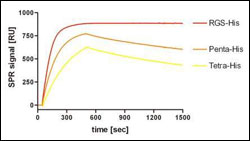Pair-wise Epitope mapping of monoclonal antibodies

The graph shows the binding of an RGS-His fusion protein to immobilised antibodies against a tetra-His, a penta-His and an RGS-His epitope. All antibodies recognize the epitope but only the anti-RGS-His antibody shows no dissociation when bound to the RGS-fusion protein after an association time of 450 seconds.
A complete characterization of monoclonal antibodies also includes the determination of epitope specificity for a given set of monoclonal antibodies. Epitope mapping is a powerful tool in analysing the surface topography of an antigen. The binding of an antibody to the antigen defines a specific binding site or epitope which sterically interferes with the binding of another antibody which has the same or a closely located binding site. The specificity of pairs of antibodies can easily be determined by testing the simultaneous binding to the antigen. Dinstinct binding sites can be identified by binding of both antibodies in parallel whereas an identical or closely located binding site prevents binding of the second antibody. BIA technology (Biomolecular Interaction Analysis) is ideally suited to automatically test panels of monoclonal antibodies and define their epitope specificity pattern.
Our antibody service “eitope mapping” includes the generation of working plans for the experimental setup, the performance of the epitope mapping analysis on a Biacore instrument and the complete evaluation of the results documented in a written report with figures. This report provides you with information about the epitope specificity pattern for your set of monoclonal antibodies i.e. which antibodies bind to the same epitope and which can bind simultaneously because they have different binding sites on the antigen. Please enquire for a detailed quote concerning your specific problem.
Media Contact
More Information:
http://www.biaffin.comAll latest news from the category: Life Sciences and Chemistry
Articles and reports from the Life Sciences and chemistry area deal with applied and basic research into modern biology, chemistry and human medicine.
Valuable information can be found on a range of life sciences fields including bacteriology, biochemistry, bionics, bioinformatics, biophysics, biotechnology, genetics, geobotany, human biology, marine biology, microbiology, molecular biology, cellular biology, zoology, bioinorganic chemistry, microchemistry and environmental chemistry.
Newest articles

Machine learning algorithm reveals long-theorized glass phase in crystal
Scientists have found evidence of an elusive, glassy phase of matter that emerges when a crystal’s perfect internal pattern is disrupted. X-ray technology and machine learning converge to shed light…

Mapping plant functional diversity from space
HKU ecologists revolutionize ecosystem monitoring with novel field-satellite integration. An international team of researchers, led by Professor Jin WU from the School of Biological Sciences at The University of Hong…

Inverters with constant full load capability
…enable an increase in the performance of electric drives. Overheating components significantly limit the performance of drivetrains in electric vehicles. Inverters in particular are subject to a high thermal load,…





















